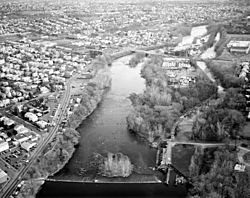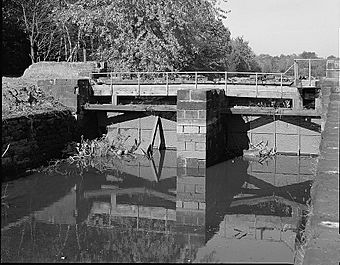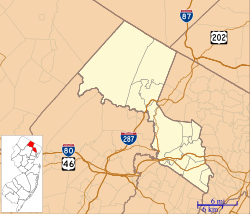Dundee Canal facts for kids
Quick facts for kids Dundee Canal |
|
|---|---|

Dundee Canal (right) in 1997, with Passaic River in the center. Looking southeast, with Garfield on the left bank of the river and Passaic on the right. The Dundee Dam with headgate for the canal is in the foreground, and the former Dundee Textile Mill is seen between the river and canal.
|
|
| Specifications | |
| Length | 1.8 mi (2.9 km) |
| Status | Abandoned |
| History | |
| Original owner | Dundee Manufacturing Company |
| Construction began | 1858 |
| Date of first use | July 1861 |
| Date completed | 1861 |
| Date closed | c. 1930s |
| Geography | |
| Start point | Clifton, New Jersey |
| End point | Passaic, New Jersey |
| Beginning coordinates | 40°52′57″N 74°07′37″W / 40.8825°N 74.127°W |
| Ending coordinates | 40°52′23″N 74°07′00″W / 40.873°N 74.1167°W |
| Connects to | Passaic River |
The Dundee Canal was a special waterway built for factories in Clifton and Passaic, New Jersey. It was dug between 1858 and 1861. This canal ran right next to the Passaic River.
Its main job was to provide water power and water for different kinds of manufacturing. Some people wanted to use the canal for boats, but it was never actually used for shipping. The canal, along with new railroads, helped the towns of Passaic and the surrounding areas grow very quickly in the late 1800s and early 1900s.
Contents
What Was the Dundee Canal Like?
The Dundee Canal was about 1.8 miles (2.9 km) long. At its northern end, there was a special wall called the Dundee Dam built across the Passaic River. This dam helped direct water into the canal.
The dam was the lowest point on the river where water power was used. It was just above the tidal zone, which is where the river's water level changes with the ocean's tides.
How Did the Canal Start and Grow?
Building the Canal and Early Years
In 1857, the government of New Jersey allowed the company that owned the dam to make the water level higher. This caused some nearby areas to flood, creating a new area called Dundee Lake.
Because of this flooding, some factory owners and others in the community suggested making the canal wide enough for boats. Using a canal for both power and shipping would have been quite unusual.
The company, which had changed its name in 1850, built the Dundee Canal from 1858 to 1861. However, the canal did not make much money from boat traffic. The company faced financial trouble in 1864.
It then reorganized in 1872 as the Dundee Water Power and Land Company (DWPLC). This new company focused on providing water and selling land, which turned out to be much more profitable.
A Boost for Factories and Towns
The Dundee Canal offered a steady supply of water. This water was great for powering machines and for use in factory processes. Also, railroad lines were built nearby.
These two things – reliable water and easy train access – attracted many factories to Passaic for several decades. The population of Passaic quickly grew. It doubled between 1860 and 1880, reaching 6,500 people.
Many large textile mills, which made fabric, started up. One famous one was the Botany Worsted Mills, founded in 1889. By 1900, the city's population had jumped to 25,000.
As more people moved to the area, the canal water became dirtier. This made it less useful for textile mills. However, other industries, like those making rubber and paper, could still use the water. It was also important for fighting fires.
The Canal in the 1900s
During the Great Depression in the 1930s, factories used the canal much less. Woolen manufacturing also slowed down. The canal started to collect a lot of trash.
In the late 1930s, the City of Passaic rented part of the canal. They put a large pipe (a culvert) inside it and paved over the top. This area was then used for parking lots and other public spaces.
After World War II, the canal changed owners several times. A group of investors bought the DWPLC in 1946. Then, in 1974, the Hackensack Water Company bought it. More parts of the canal were filled in and paved over when New Jersey Route 21 was built starting in the 1960s.
Dundee Canal Industrial Historic District
 |
|
| Nearest city | Passaic, New Jersey |
|---|---|
| Area | 66 acres (27 ha) |
| Built | 1858 |
| Architect | Kick, Ludwig; et al. |
| Architectural style | Colonial Revival, Functional industrial |
| NRHP reference No. | 98001640 |
| Significant dates | |
| Added to NRHP | January 21, 1999 |
The Dundee Canal Industrial Historic District was added to the National Register of Historic Places on January 21, 1999. This means it's a special area recognized for its historical importance.
The district includes the canal itself and several old textile mills. These include the famous Botany Worsted Mills. It also covers the Acquackanonk Water Company Site and other related buildings.
Images for kids





